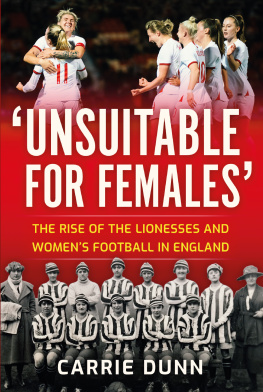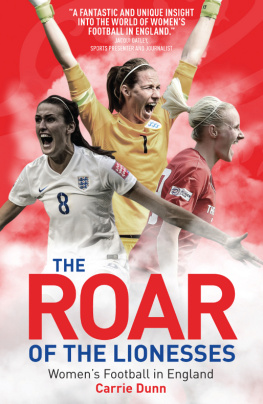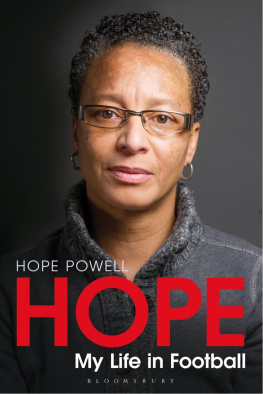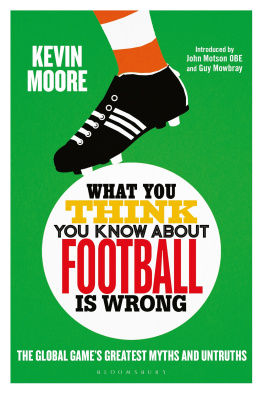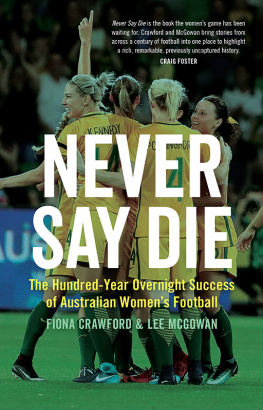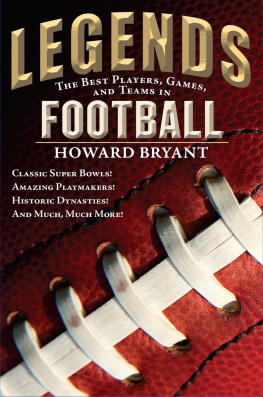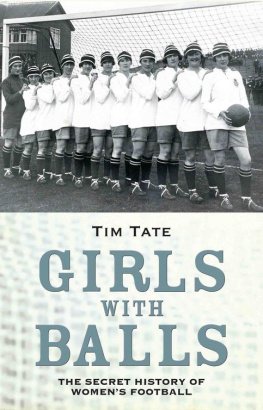Pagebreaks of the print version

The History of Womens Football
The History of Womens Football
Jean Williams
First published in Great Britain in 2021 by
Pen & Sword History
An imprint of
Pen & Sword Books Ltd
Yorkshire Philadelphia
Copyright Jean Williams 2021
ISBN 978 1 52678 531 2
eISBN 978 1 52678 532 9
The right of Jean Williams to be identified as Author of this work has been asserted by her in accordance with the Copyright, Designs and Patents Act 1988.
A CIP catalogue record for this book is available from the British Library.
All rights reserved. No part of this book may be reproduced or transmitted in any form or by any means, electronic or mechanical including photocopying, recording or by any information storage and retrieval system, without permission from the Publisher in writing.
Pen & Sword Books Limited incorporates the imprints of Atlas, Archaeology, Aviation, Discovery, Family History, Fiction, History, Maritime, Military, Military Classics, Politics, Select, Transport, True Crime, Air World, Frontline Publishing, Leo Cooper, Remember When, Seaforth Publishing, The Praetorian Press, Wharncliffe Local History, Wharncliffe Transport, Wharncliffe True Crime and White Owl.
For a complete list of Pen & Sword titles please contact
PEN & SWORD BOOKS LIMITED
47 Church Street, Barnsley, South Yorkshire, S70 2AS, England
E-mail:
Website: www.pen-and-sword.co.uk
Or
PEN AND SWORD BOOKS
1950 Lawrence Rd, Havertown, PA 19083, USA
E-mail:
Website: www.penandswordbooks.com
Acknowledgements
I would like to thank Simon, and our little cat, Bubby, for their longstanding support and, in Simons case, patience. The cat found my tip-tapping away on the laptop while he snoozed rather irritating and would often sit on the keyboard to maintain a serene silence. This gave me cause for quiet reflection. And some additional characters which may have made their way into the manuscript. He was my first, and most severe critic.
I would like to thank the women who have shared their stories with me, and the staff of the National Football Museum, past and present who have helped to collect the oral histories. This is precious stuff, often neglected and so all the more valuable. Thank you, and I hope to have done your story justice.
Introduction
Y ou may well find preconceptions that womens football is new or recently developing challenged in this book. The first chapter concerns the beginning of the modern history of womens football, focusing on Nettie Honeyball who played in the early matches, the first of which took place in 1895 at Crouch End in front of 10,000 paying spectators. The initiative proved successful and would expand. Later, Mrs Helen Matthews became an important leader of a breakaway team, as did Nellie Hudson. Altogether, between 189495 and 190203 these teams played over 166 fixtures, as well as practice matches, covering the whole of England, Scotland, Northern Ireland and Wales. Most were played on significant grounds in front of a paying public to raise as much money as possible: an emerging professional formula for womens football.
But before we cover the success of the Honeyball business model for womens football in more detail, we must pause. Many people consider womens football to be a more recent innovation and would be surprised that it was played in the late nineteenth century. But Nettie, Nellie and Helen would not be the first women to play football. For that, we have to go back much further in time.
Womens Folk Football, Cuju and Barley Breaks before 1863
Women have been known to play ball games for as long as ball games have existed. There were many unregulated forms of womens football before the establishment of the Football Association (who wrote the modern Laws of the Game in 1863).
One such example was the centuries-old games in China known as Cuju (pronounced shoo-ju) in which the main skills and rules changed. In Cuju s varied history there were womens teams, and female expert players such as Peng Xiyun, who juggled the ball with her feet, head knees and chest, much in the same way that Freestyle champions do today.
Folk football games took many forms in the Americas, Europe and Africa, often staged as part of fertility rites, especially linked with harvest and the agricultural calendar. Egyptian hieroglyphs and Greek artifacts show women taking part in ball games. In Europe, and particularly Britain, Whitsun was a traditional time to play matches, to celebrate abundance or potency, and here the ball was symbolic of the seed being successfully sown into the earth and harvested. Fixtures that rejoiced in a good harvest were often called barley breaks, popular with both men and women agricultural labourers, and often linked with feasting, dancing and celebration. There were also married women versus single women matches. Folk football was played with many different kinds of balls, from skins inflated with pigs bladders to more solid objects. Because folk football was often violent and linked to drinking, people could get hurt, so it was often banned by monarchs in favour of more useful activities such as archery, which could be used in times of war.
The Football Associations simple rules, the Laws of the Game, differentiated kicking codes from those that authorised handling the ball. Modern football had written rules and was gradually regulated under the Laws of the Game from 1863 onwards. Many football codes, such as Rugby Union Football, Rugby League Football, American Football, Australian Rules, Gaelic Football and so on, shared aspects of the same rules early on and increasingly differentiated their rules so that each game form became quite different.
In the transition from folk football to modern football, sometimes teams would play one half of a game under one set of rules and the other half under a another set of rules. This can make it difficult to say, definitively, that a particular match in the mid-nineteenth century was a game of Association Football because newspaper reports were not clear which code was being played, or even if it was a mixture. But we know that women have played various forms of football for centuries. As with games played on village greens and street football, there are often few newspaper sources, and no photographs, so evidence can be sketchy.
What we can also be sure of is that women helped to promote football during the period when it was becoming standardised and modernised, roughly between the 1840s and the mid-1860s. For instance, the Foot Ball Club Spa in Liege, Belgium, was an experiment undertaken in 1863 by Scottish aristocrats Sir Edward and Lady Helen Hunter-Blair as club patron and patroness with their friends the Fairlies. Although it does not seem to have been long lived, more of a holiday project, the Hunter-Blairs sons and daughters were listed as ordinary members. There may well be other similar examples.
Like many of these games, Association Football is essentially an invasion game, where a team takes the territory of the other by moving the ball. The scoring system involves placing the ball in the opponents net, and so winning the most important territory that each team defends, the goal. Football is a relatively low scoring game. The rules are designedly inefficient. Without the rules, it would be much easier to be able to stick the ball up your shirt, run the length of the pitch and place it in the goal. But the laws prevent this from happening. So they make the players combine as a team to try and invade the opponents territory, through a combination of speed and skill. Sometimes the teams can be drawn, and, with two teams of eleven, there are a high number of player interactions over 90 minutes of play, making it hard to predict.



